Fourth graders from Frederick Douglass School and the Spencer Center have a combined history club. The Douglass kids stay after school; always start with a snack and a half hour of history before we go to Spencer. Then we walk over to the Spencer which is still is in session and work together with the fourth graders there for another 40 minutes. If the weather is nice, we all walk to seem some interesting buildings in Walnut Hills, within just a few blocks of our two schools.
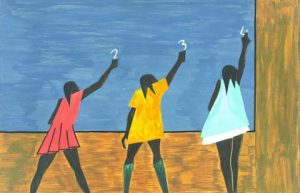
Jacob Lawrence Great Migration
The Douglass kids started with a book about the Great Migration by the African American painter Jacob Lawrence. The 60 paintings show some of the causes for the Migration of African Americans from the rural South to the industrial North, each with a short caption by Lawrence. The captions were written for grownups, so we needed some help with some of the bigger words and with the ideas behind them. The Douglass kids really understood the meaning once they got the words. So many “push” factors have stayed the same: lack of respect for African Americans, lack of work, poor housing, poverty, an unfair criminal justice system, along with special issue like drought and the boll weevil. They also understood the commotion of moving, and could understand why attempts to keep African Americans in the South caused so much frustration. They liked some of the “pull” factors, especially the idea of good schools.
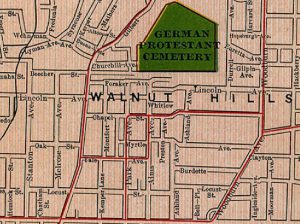 Before the weather warmed up students from both schools looked at some maps of Walnut Hills from different times to see how things have changed. We found some old names for streets, like Elm street for Alms Place where the old Douglass School building was located, and we saw some major roads, Victory Parkway and Martin Luther King Drive, that cut through the community not far from our schools. We even used magnifying glasses to examine prints of some of the old maps! We also saw that the busy William Howard Taft Road used to be called Locust,, and that if took little “jogs” a couple of places near our schools. A block east of Alms, the street now called Preston used to be called Willow. An African American man named Dangerfield Earley lived on Willow; he started a school for Black children in his home. That private school was the predecessor to the original Frederick Douglass School.
Before the weather warmed up students from both schools looked at some maps of Walnut Hills from different times to see how things have changed. We found some old names for streets, like Elm street for Alms Place where the old Douglass School building was located, and we saw some major roads, Victory Parkway and Martin Luther King Drive, that cut through the community not far from our schools. We even used magnifying glasses to examine prints of some of the old maps! We also saw that the busy William Howard Taft Road used to be called Locust,, and that if took little “jogs” a couple of places near our schools. A block east of Alms, the street now called Preston used to be called Willow. An African American man named Dangerfield Earley lived on Willow; he started a school for Black children in his home. That private school was the predecessor to the original Frederick Douglass School.
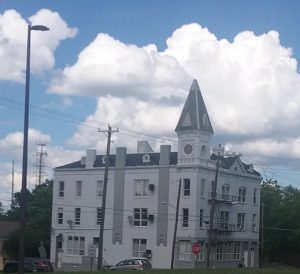 On our first walk, we stopped to look at the Peerless Building on Chapel and learned that the Peerless Drug Store was operated by Anna Beckwith, an African American woman. Beckwith bought the store in 1923. The building has a cool spire, like a lot of churches, but it was just a store with apartments upstairs.
On our first walk, we stopped to look at the Peerless Building on Chapel and learned that the Peerless Drug Store was operated by Anna Beckwith, an African American woman. Beckwith bought the store in 1923. The building has a cool spire, like a lot of churches, but it was just a store with apartments upstairs.
Students observed stone steps on Chapel that didn’t lead to houses. We figured out that the houses were torn down to make way for the busy Martin Luther King Boulevard. The students wondered whether it was fair that people had to move to make way for the road. We decided it wasn’t.
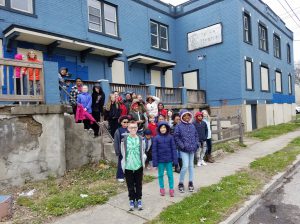 Next we saw the Gordon Terrace apartments, housing built about 100 years ago for working Black families. (Visit the Walnut Hills Historical Society web site low cost housing story for more information on the Model Homes company and Jacob Schmidlapp’s development of workforce housing in Walnut Hills.)
Next we saw the Gordon Terrace apartments, housing built about 100 years ago for working Black families. (Visit the Walnut Hills Historical Society web site low cost housing story for more information on the Model Homes company and Jacob Schmidlapp’s development of workforce housing in Walnut Hills.)
On the way back, we looked across Victory Parkway at the original Walnut Hills High School, and remembered that the first African American Olympic gold medalist DeHart Hubbard had gotten his start before he graduated from Douglass and Walnut Hills.
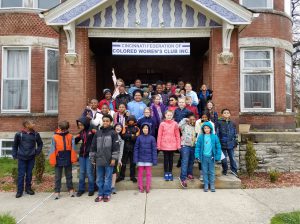 The next week we walked west on Chapel to the Federation of Colored Women’s Clubs house. We talked about how the house provided housing for young single women and women with children, mostly for recent migrants from the South. The individual clubs sponsored charities like the Colored Orphans Asylum and homes for Old Women and Old Men, and supported students at Douglass School with donations of clothing, food, and other necessities. There were a number of perceptive questions about government support of similar institutions for social services for white people.
The next week we walked west on Chapel to the Federation of Colored Women’s Clubs house. We talked about how the house provided housing for young single women and women with children, mostly for recent migrants from the South. The individual clubs sponsored charities like the Colored Orphans Asylum and homes for Old Women and Old Men, and supported students at Douglass School with donations of clothing, food, and other necessities. There were a number of perceptive questions about government support of similar institutions for social services for white people.
We also saw the Manse Hotel building next door and talked about the segregation of luxury hotels that excluded Blacks. The Manse was the nicest hotel in Cincinnati for visiting African Americans, and hosted many famous musicians, athletes and business travelers.
The next week,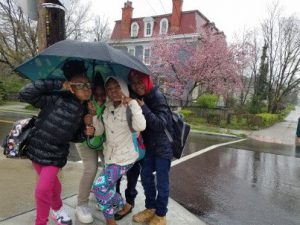 Douglass kids finished their reading of the paintings and captions by the African American Artist Jacob Lawrence, had had lots of good questions about the last series on the segregation and racism the migrants experienced in the North. The hardest question, which I can’t answer, is “Why were white people so mean?”
Douglass kids finished their reading of the paintings and captions by the African American Artist Jacob Lawrence, had had lots of good questions about the last series on the segregation and racism the migrants experienced in the North. The hardest question, which I can’t answer, is “Why were white people so mean?”
The weather improved from last week’s snow to moderate rain. The intrepid Douglass students again walk through the weather to join the Spencer Center fourth grades. We also stopped for a moment to huddle under an umbrella at the house that served as the first building for Children’s Hospital. For more information, see the Walnut Hills Historical Society web site.We didn’t do any more walking, but we read about two buildings we pass each week when we walk to Spencer: right across the street from the front door at Douglass is 2636 Park, the Walnut Hills apartment building that Horace Sudduth used as his Walnut Hills residence.
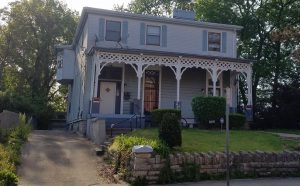 Sudduth was perhaps the first African American millionaire in Walnut Hills. He started out in real estate in the West End. To allow African Americans to buy homes, he founded the Industrial Building and Loan company, a state and later federally chartered Savings and Loan. Sudduth served as president but took a salary of only a dollar a year. He raised money, and chaired the Committee of Management, for the Black YMCA downtown. And served as a trustee at the Colored Orphans Asylum and at the Colored Industrial School. In Walnut Hills he owned the Hotel Terry next to the Federation of Colored Women’s Clubs on Chapel; in 1950 he remodeled and enlarged the hotel as the Manse Hotel, a luxury hotel for visiting Black travelers in the segregated 1950’s and early ‘60’s. (We walked to the Federation building and the former Manse a couple of weeks ago.)
Sudduth was perhaps the first African American millionaire in Walnut Hills. He started out in real estate in the West End. To allow African Americans to buy homes, he founded the Industrial Building and Loan company, a state and later federally chartered Savings and Loan. Sudduth served as president but took a salary of only a dollar a year. He raised money, and chaired the Committee of Management, for the Black YMCA downtown. And served as a trustee at the Colored Orphans Asylum and at the Colored Industrial School. In Walnut Hills he owned the Hotel Terry next to the Federation of Colored Women’s Clubs on Chapel; in 1950 he remodeled and enlarged the hotel as the Manse Hotel, a luxury hotel for visiting Black travelers in the segregated 1950’s and early ‘60’s. (We walked to the Federation building and the former Manse a couple of weeks ago.)
The next week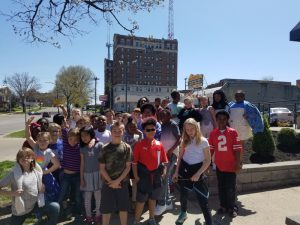 Douglass kids started their walk right after school this week. We finally had perfect weather! We looked down William Howard Taft. We saw the Walnut Hills Library at Kemper Lane; the Douglass students know it well. We saw the Alexandra Apartments next door to the library, a large, beautiful building that was built just a few years before the library. Across Gilbert Avenue we could see the steeple to the old Walnut Hills Presbyterian Church preserved when the rest of the church was torn down.
Douglass kids started their walk right after school this week. We finally had perfect weather! We looked down William Howard Taft. We saw the Walnut Hills Library at Kemper Lane; the Douglass students know it well. We saw the Alexandra Apartments next door to the library, a large, beautiful building that was built just a few years before the library. Across Gilbert Avenue we could see the steeple to the old Walnut Hills Presbyterian Church preserved when the rest of the church was torn down.
We then joined the fourth graders at Spencer and continued our walk. Today we talked about Frederick Alms; the Spencer Center is on Alms Place. Some of the students remembered that the Spencer site was originally called the Elm Street School. Frederick Alms was a native of Cincinnati who enlisted in the Union Army in the Civil War. After the war he and a brother and cousin found the Alms and Doepke dry goods store, which became the largest department store and dry goods wholesaler in Ohio. Frederick and Eleanora Alms moved to Walnut Hills and built a hotel across the street from their home on McMillan. The last and largest building went up in 1925. It was the finest hotel outside of downtown and competed with the luxury hotels there.
We talked about how the Hotel Alms was a popular place for music and dancing. During the 1920’s there was lots of jazz at the Alms, although only white people were allowed in the hotel. We realized that Black Walnut Hills also had lots of good jazz. We also noticed the broadcast towers on top of the building, and the WKRC letters below the Hotel Alms sign. I need to work on explaining to school children about what a big thing radio used to be, broadcasting live music from a ballroom to the city. “Cool” somehow didn’t do it.
Finally, we looked across the street from the hotel, and saw St. Anthony of Padua, a Maronite Catholic Church which traces its roots to Syria and Lebanon in the 4th and 5th centuries. We learned that the building first served as a synagogue — a Jewish Temple — from the 1910’s through the ‘40’s. Walnut Hills, always a diverse neighborhood, had a large Jewish population from the 1880’s. Even before that, around the time Alms bought his mansion at McMillan and Elm (or Elmwood), the Synagogue site was the home of Robert Gordon. Gordon was a former slave who ran his master’s coal business. He was allowed to trade the low-quality coal on the side; he earned enough money to buy his own freedom. He came to Cincinnati and despite organized opposition from white dealers he made a large fortune.
The next week we talked about three early African American Churches in the neighborhood. Dangerfield Earley, a Baptist, and Peter Clark, a Methodist, together organized the First Church of Walnut Hills in 1855. (Peter Clark was the first teacher in the African American Public Schools in Cincinnati, beginning in 1849.)
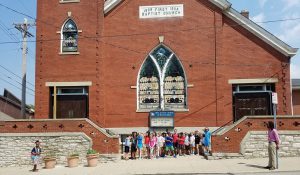 By 1862 the congregation grew large enough to support separate Baptist and Methodist churches. Dangerfield Earley ministered to the renamed First Baptist Church until his death in 1884. He also had a private school for African American children in his home on Willow (now Preston). We remembered that we had passed Preston on an earlier walk.
By 1862 the congregation grew large enough to support separate Baptist and Methodist churches. Dangerfield Earley ministered to the renamed First Baptist Church until his death in 1884. He also had a private school for African American children in his home on Willow (now Preston). We remembered that we had passed Preston on an earlier walk.
The Methodists organized Brown Chapel A. M. E. (African Methodist Episcopal). It first met in Peter Clark’s home on Kemper Street, now called Yale. The congregation built a Church at the corner of Preston and Whitlow (now Martin Luther King). In 1870, Benjamin Arnett became the pastor. Arnett would go on to become president of Wilberforce College, the oldest historically Black College in the country, and to the state legislature in 1885.
 In 1892, some members of the First Baptist Church founded Bethel Baptist Church. The Earley family, and the Parham family which included many generations of Black educators in Cincinnati, joined Bethel Baptist. The original Bethel Baptist building is still on Alms Place, a block south of the old Douglas School and two blocks east of new Douglass. While it is the newest congregation of the three, it has the oldest building. One of the stained glass windows memorializes Dangerfield and Georgina Earley.
In 1892, some members of the First Baptist Church founded Bethel Baptist Church. The Earley family, and the Parham family which included many generations of Black educators in Cincinnati, joined Bethel Baptist. The original Bethel Baptist building is still on Alms Place, a block south of the old Douglas School and two blocks east of new Douglass. While it is the newest congregation of the three, it has the oldest building. One of the stained glass windows memorializes Dangerfield and Georgina Earley.
Across Myrtle from Bethel Baptist, directly across Alms Place from Spencer, is Brown Chapel A. M. E.’s current building, constructed by the congregation in the 1930’s through the ‘50’s.
The next week was very hot. In this weather the Douglass kids stayed inside looked at a few Jacob Lawrence paintings from his Frederick Douglass series. We decided the paintings were great, but the words were a lot harder to read than the captions for his Great Migration series we read earlier. (If we look at the Frederick Douglass paintings next year, maybe we’ll need to supply alternate text.)
Then we walked over to Spencer and picked up the fourth graders there. We headed up Park Avenue to Lincoln. We stopped at the African American First Baptist Church We talked about First Baptist last week when we walked by Brown Chapel A. M. E. and Bethel Baptist, so this week we posed in front of it.
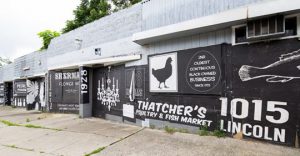 Then we walked west on Lincoln to Gilbert. We saw how many vacant lots there are in those blocks of Lincoln, and we saw that the buildings still standing are mostly abandoned. We could see that Lincoln Avenue was interrupted by Martin Luther King Drive a block east of First Baptist, and thought about how that wide, busy road broke up the old Lincoln Avenue business district. We stopped for a few minutes to look at the display of historical Black businesses pasted on the abandoned storefronts around 920 Lincoln.
Then we walked west on Lincoln to Gilbert. We saw how many vacant lots there are in those blocks of Lincoln, and we saw that the buildings still standing are mostly abandoned. We could see that Lincoln Avenue was interrupted by Martin Luther King Drive a block east of First Baptist, and thought about how that wide, busy road broke up the old Lincoln Avenue business district. We stopped for a few minutes to look at the display of historical Black businesses pasted on the abandoned storefronts around 920 Lincoln.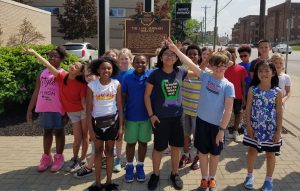 We swung south on Gilbert and stopped at the Thompson Cadillac building to read the historical marker there. It commemorates the Lane Seminary Debates from 1834, when students at the (then brand new) Seminary decided to support the abolition of slavery. We walked back east on Chapel to Spencer, and on our way, we passed the old Manse Hotel and the Cincinnati Federation of Colored Women’s Clubs – places we visited on earlier walks.
We swung south on Gilbert and stopped at the Thompson Cadillac building to read the historical marker there. It commemorates the Lane Seminary Debates from 1834, when students at the (then brand new) Seminary decided to support the abolition of slavery. We walked back east on Chapel to Spencer, and on our way, we passed the old Manse Hotel and the Cincinnati Federation of Colored Women’s Clubs – places we visited on earlier walks.